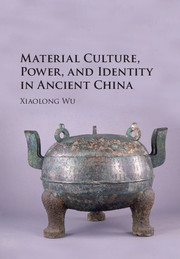Book contents
- Frontmatter
- Dedication
- Contents
- List of Figures
- List of Maps
- List of Tables
- Acknowledgments
- INTRODUCTION
- 1 HISTORICAL SETTING AND APPROACHES TO THE STUDY OF AN ANCIENT STATE IN WARRING STATES CHINA
- 2 LIFE, DEATH, AND IDENTITY IN ZHONGSHAN: SORTING OUT THE ARCHAEOLOGICAL EVIDENCE
- 3 ROYAL MORTUARY PRACTICE AND ARTIFACTS: HYBRIDITY, IDENTITY, AND POWER
- 4 INTERSTATE POLITICS AND ARTISTIC INNOVATION DURING THE REIGN OF KING CUO
- 5 STATECRAFT AND ZHONGSHAN BRONZE INSCRIPTIONS
- 6 FUNERARY ARCHITECTURE, KINGLY POWER, AND COURT POLITICS
- CONCLUSION
- Appendices
- Notes
- Bibliography
- Index
CONCLUSION
Published online by Cambridge University Press: 23 March 2017
- Frontmatter
- Dedication
- Contents
- List of Figures
- List of Maps
- List of Tables
- Acknowledgments
- INTRODUCTION
- 1 HISTORICAL SETTING AND APPROACHES TO THE STUDY OF AN ANCIENT STATE IN WARRING STATES CHINA
- 2 LIFE, DEATH, AND IDENTITY IN ZHONGSHAN: SORTING OUT THE ARCHAEOLOGICAL EVIDENCE
- 3 ROYAL MORTUARY PRACTICE AND ARTIFACTS: HYBRIDITY, IDENTITY, AND POWER
- 4 INTERSTATE POLITICS AND ARTISTIC INNOVATION DURING THE REIGN OF KING CUO
- 5 STATECRAFT AND ZHONGSHAN BRONZE INSCRIPTIONS
- 6 FUNERARY ARCHITECTURE, KINGLY POWER, AND COURT POLITICS
- CONCLUSION
- Appendices
- Notes
- Bibliography
- Index
Summary
THIS BOOK HAS EXAMINED THE ECLECTIC ASSEMBLAGE OF ZHONGSHAN artifacts with three questions in mind. One is what technical, iconographic, and stylistic traditions informed the production of Zhongshan artifacts and how knowledge about them was made available to Zhongshan. The question involves stylistic comparison and analysis of social mechanisms such as trade, migration, and conquest. The second question is how the identity and power of the Zhongshan patrons were visualized by their material culture and burial practice. The third question is how bronze artifacts could help the patron to deal with problems raised by specific sociopolitical conditions at certain historical moments. All of these questions involve analysis of the historical context in which the bronzes were commissioned and the sociopolitical roles they were intended to play. Zhongshan artifacts reflect the combined working of technology, stylistic traditions, cultural interactions, political intentions, and social relations. To answer these interrelated questions, I have used a variety of evidence that involve burial practice, stylistic analysis of artifacts, historical texts, and inscriptions.
The above discussions have reached the following conclusions. First, the Zhongshan rulers negotiated and asserted their identities through the production and display of bronze artifacts. In material culture, burial practice, and the political ideology reflected by the bronze inscriptions, the Zhongshan kings emphasized a Huaxia cultural identity, but meanwhile also displayed traditions and styles adopted from non-Huaxia cultures, suggesting affiliations with both Central Plain states and groups along the northern frontier of the Zhou states. The mixed material culture and burial practices of the Zhongshan elite, based on a synthesis of several traditions, constructed a unique, hybrid cultural identity, distinct from any of the traditions it adopted. The styles of bronzes made in the official workshops of the Zhongshan kings demonstrated artistic creativity and freedom. The innovation in their production and use took on a very special local importance as evidence of Zhongshan's political and cultural independence and strength. Zhongshan kings gradually took on their own cultural identity that drew upon earlier Zhou traditions, the concepts and arts of other states, and the traditions of the northern groups outside the Zhou cultural sphere. This cultural identity was used as a means to weld a multiethnic population together in order to maintain internal solidarity and to cope with external challenges.
- Type
- Chapter
- Information
- Material Culture, Power, and Identity in Ancient China , pp. 180 - 182Publisher: Cambridge University PressPrint publication year: 2017



